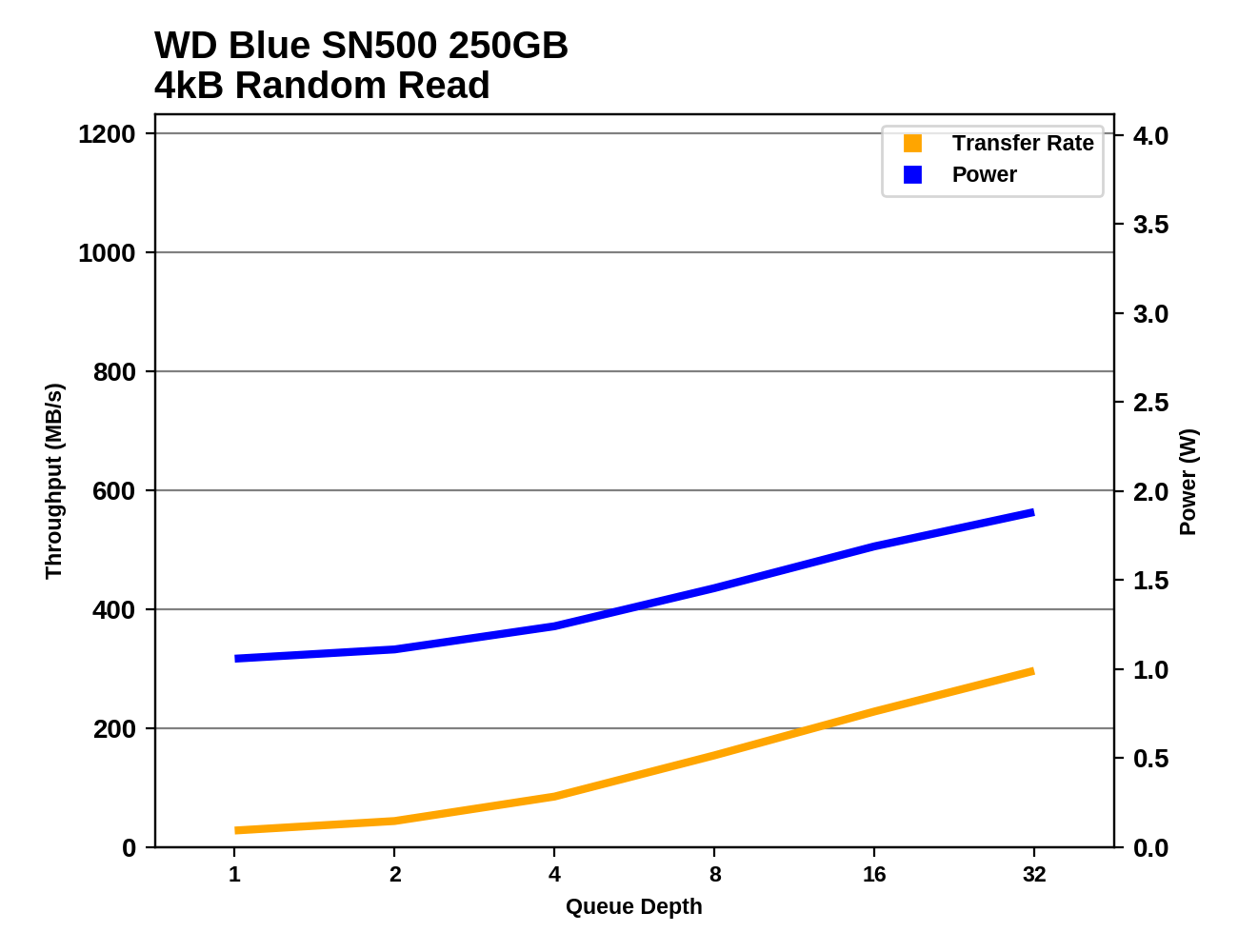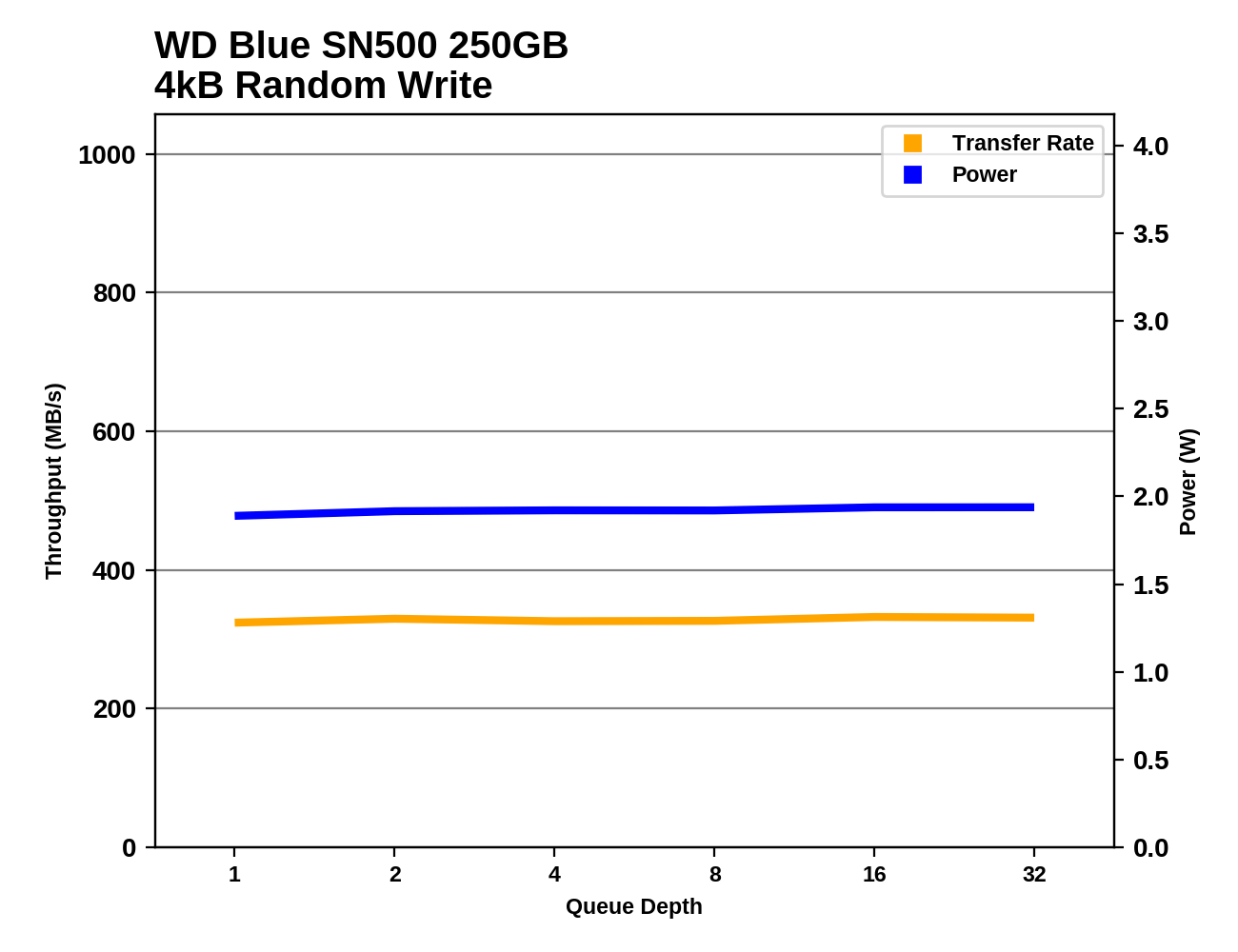The Western Digital WD Blue SN500 SSD Review: Moving The Mainstream To NVMe
by Billy Tallis on April 19, 2019 9:30 AM ESTRandom Read Performance
Our first test of random read performance uses very short bursts of operations issued one at a time with no queuing. The drives are given enough idle time between bursts to yield an overall duty cycle of 20%, so thermal throttling is impossible. Each burst consists of a total of 32MB of 4kB random reads, from a 16GB span of the disk. The total data read is 1GB.

This test is confined to a 16GB portion of the drive, but the WD Blue SN500 requires more spatial locality than that to offer its best random read performance, due to its DRAMless design with only a small on-controller buffer and no HMB support. The SN500 ends up as the worst-performing NVMe drive in the bunch and only beats the Toshiba TR200 DRAMless SATA SSD.
Our sustained random read performance is similar to the random read test from our 2015 test suite: queue depths from 1 to 32 are tested, and the average performance and power efficiency across QD1, QD2 and QD4 are reported as the primary scores. Each queue depth is tested for one minute or 32GB of data transferred, whichever is shorter. After each queue depth is tested, the drive is given up to one minute to cool off so that the higher queue depths are unlikely to be affected by accumulated heat build-up. The individual read operations are again 4kB, and cover a 64GB span of the drive.

On the longer random read test, the SN500 still fares poorly, but now that the test span has widened to 64GB, the Toshiba RC100's host memory buffer is also not large enough, and the RC100 falls behind the SN500.
 |
|||||||||
| Power Efficiency in MB/s/W | Average Power in W | ||||||||
The WD Blue SN500 and Toshiba RC100 draw significantly less power than any of the other NVMe drives during the random read test, with a low-QD average of a bit over 1W. This translates to a good but not great efficiency score for the SN500: the larger drives with much better performance have considerably better efficiency, as does the Samsung 850 EVO that provided 60% better performance without drawing any more power.
 |
|||||||||
All of the 250GB-class SSDs have limited potential for performance increases at high queue depth compared to higher capacity drives, but the SN500's performance scaling is poor even within its capacity class. Power consumption starts around 1W at QD1 and stays below 2W even at QD32, while the high-end NVMe drives start out above 2W and climb from there.
The random read performance of the WD Blue SN500 never gets out of SATA SSD territory, but the power efficiency is pretty good for the performance it does provide, especially at the higher queue depths.
Random Write Performance
Our test of random write burst performance is structured similarly to the random read burst test, but each burst is only 4MB and the total test length is 128MB. The 4kB random write operations are distributed over a 16GB span of the drive, and the operations are issued one at a time with no queuing.

This burst random write test is short enough that it doesn't come close to filling even the WD Blue SN500's tiny SLC cache, so the great performance of that cache shows through with a score that's competitive against almost any other drive in this capacity class, and only 12% slower than the 1TB WD Black SN750.
As with the sustained random read test, our sustained 4kB random write test runs for up to one minute or 32GB per queue depth, covering a 64GB span of the drive and giving the drive up to 1 minute of idle time between queue depths to allow for write caches to be flushed and for the drive to cool down.

On the longer random write test, the SLC cache on the WD Blue SN500 runs out and its performance falls out of the top tier for 256GB-class drives, but it doesn't fall very far. The SN500 still clearly outperforms the other entry-level NVMe drives we have to compare against.
 |
|||||||||
| Power Efficiency in MB/s/W | Average Power in W | ||||||||
The power efficiency score for the SN500 during the random write test is a close second place among its capacity class, and is much better than the SATA drives or other entry-level NVMe drives.
 |
|||||||||
This random write test writes much more data than can fit in the SN500's SLC write cache, so there's no opportunity for performance to bounce around depending on how much cache space was free at the start of each phase of the test. Instead, the SN500's performance and power consumption are very consistent across the entire tested range of queue depths.
The WD Blue SN500's random write performance is pretty close to the limit of what SATA SSDs can achieve, and it gets there while drawing less power than most other drives, but it doesn't set any records.












50 Comments
View All Comments
rkmcquillen - Sunday, April 21, 2019 - link
This review is glowing about this hard drive. Contrast that with StorageReview.com, which basically says "stay away". I don't understand how these 2 reviews could be so different.https://www.storagereview.com/wd_blue_sn500_nvme_s...
"the drive placed last in every performance test we put it through"
DyneCorp - Sunday, April 21, 2019 - link
Did you even read the full article from the review you posted?Conclusion:
"In the end, for users looking to upgrade an older SATA SSD or HDD the WD Blue SN500 may be an ideal candidate where price is the leading decision factor and performance comes secondary. Considering a sub-$55 entry price, the overall package is impressive."
Did you even read the review from Anandtech?
FunBunny2 - Monday, April 22, 2019 - link
"and performance comes secondary"So, I guess you're admitting that it really is any two?
DyneCorp - Monday, April 22, 2019 - link
Performance is always secondary in the consumer workspace. Even high end consumer NVMe SSDs don't touch enterprise SSDs.I know, I know, consumers should just be given i9-9900Ks and 970 PROs for free and everyone holds hands and dances and gets along. But that's not the way it works, and even SATA SSDs are more than capable of handling consumer workloads. With as small as margins are in the SSD game, we're lucky we don't pay more for less.
Why don't you go work for Micron or Toshiba/ SanDisk and then go work for Silicon Motion or Phison and develop "The People's" SSD? Hmm?
LMonty - Friday, April 26, 2019 - link
I read the review you linked and it actually recommended the SN500. Nowhere does the review state or even hint that consumers should stay away from it."the drive placed last in every performance test we put it through, though the WD drives is of a smaller capacity than its comparables". Of course it would score lower. Apples to oranges.
GruntboyX - Monday, April 22, 2019 - link
How is the latency on these drives? A system drive hardly ever does large File Transfers but ususually does a lot of random file access. Perhaps for a system drive its a good way to save some money without a significant performance penalty.I know the Samsung EVO / PRO drives are the gold standard and for good reason. However if the diminishing returns are small enough perhaps its a good cost/performance tradeoff.
....or am I missing something?
DyneCorp - Monday, April 22, 2019 - link
Samsung hasn't been the "gold standard" for several years now. SSDs utilizing Micron/ Intel NAND and Silicon Motion controllers have been on par or even outperformed Samsung SSDs. Even Intel's 660p can keep up (and even outperform) the 970 EVO in certain metrics, but SSDs utilizing Micron 64-layer and SM2262 are really what shine against Samsung (EX920 and SX8200).evan.drake - Monday, April 22, 2019 - link
Fueled by 3D NAND: https://www.wd.com/en-us/products/internal-ssd/wd-... #WDCemployeeBarry S - Tuesday, April 23, 2019 - link
I found the BAPCo SYSmark 2018 Responsiveness test very interesting. It kind of puts things in perspective. Thanks for including it.